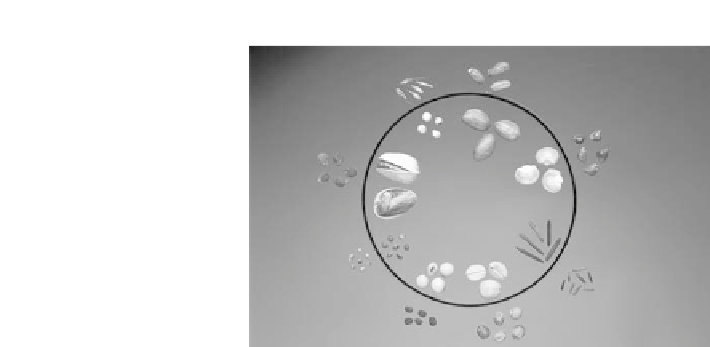Agriculture Reference
In-Depth Information
Figure
12.4.
Crop seeds and their wild relatives. (Used by permission of ARE, USDA. Photo
courtesy of Stephen Ausmus.)
humans collected and replanted this mutated species, it could be used and spread to
other communities. Maize is a unique species that needs human intervention to repro-
duce. The grains are tightly clustered together on the cob and covered by sheaths of
leaves. If the ear falls to the ground, over a hundred plants will germinate, but they
are so weak that few survive. Humans must remove the individual grains from the
husk and ear before planting them in places where each one can grow and reproduce.
This change is actually detrimental to the species in the wild but is useful to humans.
The domestication of animals has favored important changes in the species. Sheep
were selected that had fewer bristly outer hairs (the kemp) in favor of sheep that
retained more of the soft inner hairs (the wool).
6
Dogs were selected for specific abil-
ities such as racing (greyhounds), digging out badgers (dachsunds), or just as ornaments
(Pekingese). Many of these modifications make them desirable to humans but are detri-
mental to the survival of the animal in the wild.
Though we consider domestication to be useful and desirable, it actually involves
the loss of characteristics and functions that are useful in the wild. Sometimes these
losses are intentional, but other times they occur as the accidental result of other selec-
tions. These loss-of-function changes have been so great that many domesticated plants
cannot easily survive without cultivation by humans. Because of these losses, plant
breeders often search for wild relatives of a crop to recover characteristics (disease
resistance, drought tolerance) lost during domestication.
12.3.2 Conventional Breeding
Conventional breeding of plants and animals is generally considered to have begun in
1900 with the rediscovery of Mendel's works on trait inheritance.
7
This enabled plant
and animal breeders to make crosses of parents selected for special traits, such as
disease resistance, yield, color, taste, speed of maturation, and the like.
Conventional plant breeding programs have made extensive use of varieties that
have hybrid vigor. Hybrid vigor, or heterosis, is the increased vigor or yield of








